Foliar polymorphism of the genus Psidium
Dear friends, followers and members! of the Steem platform.
I take this opportunity, to share with the entire academic community of the Steemit social network, scientific-technical information about FOLIAR POLYMORPHISM, specifically of wild and cultivated specimens of the Psidium genus.
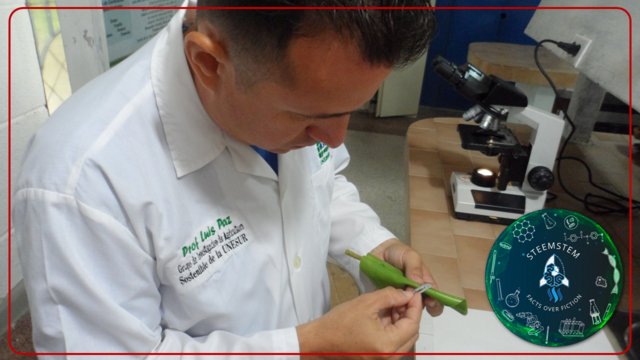
Fig. 1 Histological section tangency of leaf blades. Author: @lupafilotaxia.
Introduction
Regularly cultivated species and their wild parents, exhibit a complex morphological diversity strongly influenced by environmental pressure and plant domestication activities, these biological differentiations are widely used in plant biotechnology for genetic improvement, generally of taxa intended for human consumption call; cereals, vegetables, fruit trees, among others.
Genetic improvement studies, which focus on exo-morphological organographic plasticity (root, stem, leaf, flower, fruit), aim to improve productive aspects and plant adaptability, making use of the phenotypic variability expressed by species in Heterogeneous edaphoclimatic conditions, however, it is important to mention that the polymorphism of the leaf blades is one of the main attributes used for the selection of genotypes with agronomic potential.
Consequently and considering that the morphology of the leaves offers characters that can be related to physiological activities such as transpiration and photosynthesis, the purpose of this post aims to describe the foliar polymorphism of Psidium guajava (MYRTACEAE) specimens that grow in wild and cultivated conditions, in the search to socialize their phenotypic potentialities.
Morphological diversity
Domestication and vegetable plasticity
From the biological point of view, the plant domestication represents the morphological and histological transformation, either by evolutionary origin or by changes induced by anthropogenic artificial selection, elements that establish phenotypic and genotypic differences, between wild individuals and populations of the same species under agronomic management [3].
Organographic morphological transformation in plant species is a continuous process over time, however, it has been suggested that it varies in intensity depending on the soil and climatic conditions and the degree of genetic manipulation. For this reason, domesticated plants can present morphological diversity in contrast to their wild progenitors.
To this morphological diversity, it is known as vegetable plasticity, which are usually phenotypic changes of an adaptive nature, generated by exogenous factors among them; hydric availability, light intensity and nutritional elements, as well as endogenous conditions such as the decrease or increase of transpiration and photosynthetic activity.
Foliar polymorphism
It is called foliar polymorphism, to the variations that the leaves exhibit in their structure and shape, as a response to environmental conditions, this indicates that the leaf plates are adjusted morphologically, this evolutionary mechanism seeks to create optimal photosynthetic scenarios for growth, development, reproduction and vegetable fructification.
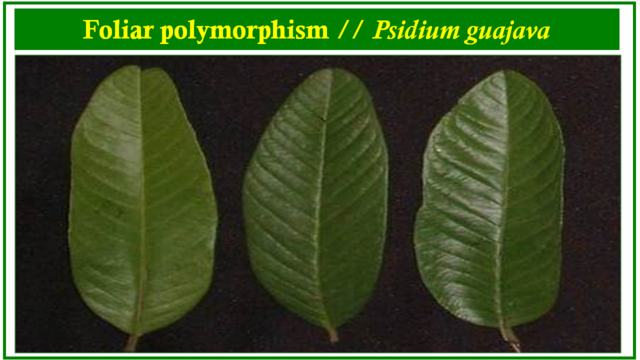
Fig. 2 Foliar polymorphism of three specimens of Psidium guajava (MYRTACEAE). Author: @lupafilotaxia.
The studies on foliar polymorphism, are focused on elucidating the phenotypic strategies that the plants admit, in front of situations of low water availability and high temperatures, recent investigations have confirmed that the decrease of the leaf area and the morphological readjustment, is not more than the ability of plant species, to reduce transpiration in environments with high solar radiation.
As regards leaf blades developed and with a greater number of stomata per unit area, they are usually related to favorable climatic conditions, however, these foliar characteristics can be affected by nutritional elements that are part of both the stomatal and photosynthetic apparatus, such as potassium and nitrogen.
Morpho-comparative study
Leaf polymorphism analysis
In order to outline some phenotypic strategies that show the plants, I will socialize with all of you a study on foliar polymorphism in Psidium guajava (MYRTACEAE), the study area corresponds to wooded relicts of the South of Lake Maracaibo - Venezuela and the production unit "La Glorieta", located in Santa Bárbara of Zulia - Venezuela.
To perform the morpho-comparative study and to determine the leaf polymorphism of wild and cultivated specimens of Psidium guajava, the leaves were characterized according to the area and the shape of the leaf; limb, base, apex and to know the stomatal density, tangential cuts were made to the leaf blades in the laboratory of Agricultural Botany of UNESUR.
Collection of specimens
Wild specimens
A field trip was made to the Vera de Agua protected area, located in the south of Lake Maracaibo - Venezuela, constituted by forest relicts, where three (03) individuals of one (01) wild Psidium guajava.
Cultivated specimens
Two (02) cultivated materials of Psidium guajava were selected, collecting three (03) individuals of each, this selection of specimens was made in the area of perennial crops of the production unit "La Glorieta" located in Santa Bárbara of Zulia - Venezuela.
Foliar polymorphism results
Leaf area
Of the specimens sampled from Psidium guajava, those with the highest leaf area were the cultivated individuals (55.25 and 54.73 cm2), whose agronomic practices are subject to irrigation, that is, they have constant water availability, in contrast to the wild individuals (47.83 cm2), which exhibited a smaller leaf area, an aspect that can probably be related to a morphological adaptation to the low availability of water.
Morphology of limbo
The results obtained in the foliar variability, showed that the two cultivated materials of Psidium guajava, do not show a relevant variation regarding the shape of the limbus, while the wild specimen does show disuniformity.
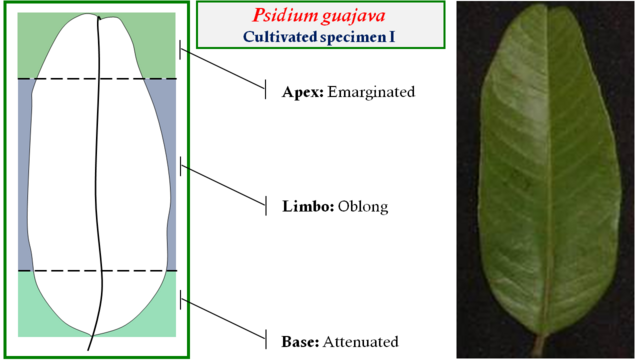
Fig. 3 On the right side, foliar sheet of Psidium guajava - Specimen I is detailed, on the left side a morphological description is indicated describing the type of shape of the apex, limb and base. Author: @lupafilotaxia.
Morphology of the base
In relation to the morphology of the base, similarity was found between the first specimen cultivated with the wild material of Psidium guajava, and appreciable variation in the second cultivated specimen.
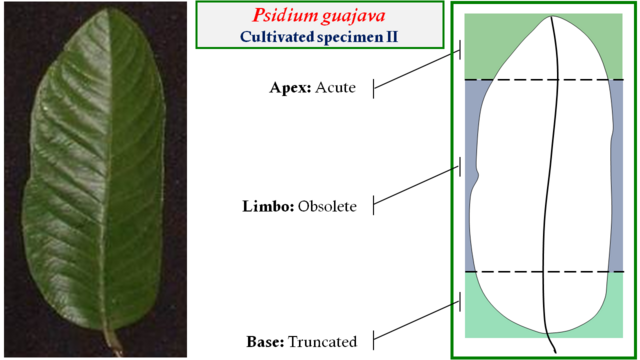
Fig. 4 On the right side, a morphological description is indicated describing the type of shape of the apex, limb and base, on the left side the foliar leaf of Psidium guajava - Specimen II is detailed. Author: @lupafilotaxia.
Apex morphology
Regarding the shape of the leaf apex, the three specimens show polymorphic diversity.
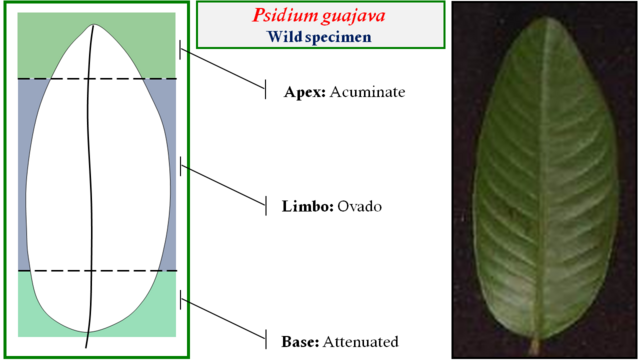
Fig. 5 On the right side, foliar sheet of Psidium guajava - wild specimen is detailed, on the left side a morphological description is indicated describing the type of shape of the apex, limb and base. Author: @lupafilotaxia.
Stomatal density
In terms of stomatal density, a greater number of stomata were recorded per leaf area in the two cultivated specimens (4.41 and 4.26 stomata / 0.0625 mm2), the lower number of stomata in the wild material (2.89 stomas / 0.0625 mm2) can be considered a strategy to avoid water loss through perspiration.
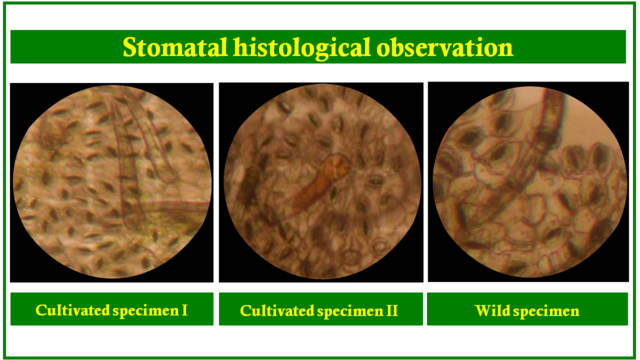
Fig. 6 Stomatal histological observation of the three specimens of Psidium guajava. Author: @lupafilotaxia.
SCIENTIFIC CONTRIBUTIONS OF THIS PUBLICATION
- Within the considerations and scientific contributions of the post, the main morphological strategies adopted by the leaves of Psidium guajava specimens, against wild or cultivated ecophysiological conditions, are established by exhibiting foliar polymorphism as a guarantee of survival, in addition to determinations of stomatal density , whose variation between the evaluated materials, evidences a predisposition to changes of expression of origin possibly epigenetic, all these socialized aspects on the adaptive morphological diversity that shows Psidium guajava, serve as a guide for studies of genetic improvement.
BIBLIOGRAPHICAL REFERENCES CONSULTED AND CITED:
[1] Ackerly D., Dudley S., Sultan S., Schmitt J., Coleman J., Linder R., Sandquist D., Gerber M., Dawson T., and Lechowicz M. The evolution of plant ecophysiological traits: Recent advances and future directions. BioScience. 2000;50:979-995.
[2] Andreae M. “The influence of torpical biomass burning on climate and tne atmospheric enviroment”. Biogeochemistry of global change. 1993;113-150.
[3] Diamond J. Evolution, consequences and future of plant and animal domestication. Nature. 2002;418: 700-708.
[4] Dussán C., Villegas H., y Miranda L. Growth analysis of guava trees (Psidium guajava L.) var. ICA Palmira II subjected to deficiency of N, P, K, Mg, Ca and B in the nursery phase. Colombian Journal of Horticultural Sciences. 2015;9:2:209-221.
[5] Martínez J., Barrientos C., Reyes M., Hernández D., Padilla R., and Mayek P. Phenotypic and genetic diversity in guava orchards of Calvillo, Aguascalientes. Rev. Fitotec. Mex. 2004;27:243-249.
[6] Singh S. Guajava (Psidium guajava L.). pp. 213-245. En: Yahia, E. (ed.). Postharvest biology and technology of tropical and subtropical fruits. Vol. 3: Cocona to mango. Woodhead Publishing, Cambridge, UK. 2011.
[7] Solarte M. Biophysical aspects and bioactive compounds of Guava (Psidium guajava L.) in the province of Vélez, Santander-Colombia. TG- National University of Colombia. 2013;151.
[8] Tong F., Medina D., y Esparza D. Variability in populations of guava (Psidium guajava L.) in the Mara municipality of Zulia state. Rev. Fac. Agron. (LUZ). 1991;8:15-27.
ATTENTION / Readers and Followers
If you want to read more scientific articles of excellent academic quality, do not waste time, and visit the label #steemSTEM, is a large community that values and promotes scientific content, mainly in the areas of Science, Technology, Engineering and Mathematics.

INVITATION
Dear reader, if you wish to obtain more information about it, join our server in Discord
OBSERVATIONS
✔ The POST 📧📨 was uploaded using the official app of https://www.steemstem.io
OBSERVATIONS
✔ The POST 📧📨 was uploaded using the official app of https://www.steemstem.io
You can visit the official app of our community
https://www.steemstem.io
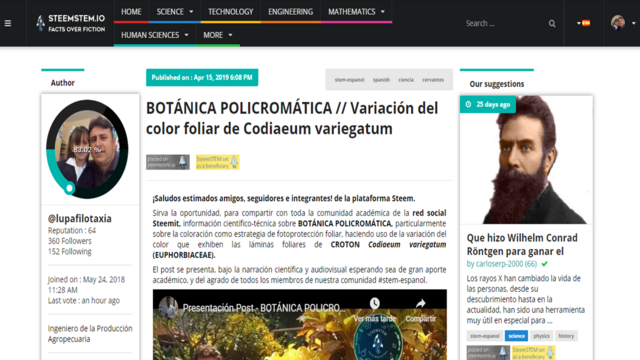

Saludos @lupafilotaxia
Interesante información proporcionada en esta publicación. Es sorprendente conocer sobre el Polimorfismo foliar, o forma fenotípica con la que las plantas se adaptan a la poca disponibilidad de agua y elevadas temperaturas por medio de la disminución del área foliar y el acomodo morfológico, permitiendo reducir la transpiración en ambientes con alta radiación solar. Por su parte, es invaluable el poder disfrutar de contenido con tal alto nivel de investigación, en este sentido muchas gracias por compartir su trabajo Profesor Paz.Saludos amigo @tramelibre, mil gracias por tus apreciadas palabras, así es, uno de los aspectos más fascinantes del mundo es precisamente el polimorfismo foliar, que desde el punto de vista agrícola tiene múltiples lecturas para el manejo Agronómico a nivel de cultivo. Nuevamente gracias
Wonderful! Thank you!
Thank you for the support provided.
This post has been voted on by the SteemSTEM curation team and voting trail. It is elligible for support from @curie and @utopian-io.
If you appreciate the work we are doing, then consider supporting our witness stem.witness. Additional witness support to the curie witness and utopian-io witness would be appreciated as well.
For additional information please join us on the SteemSTEM discord and to get to know the rest of the community!
Thanks for having added @steemstem as a beneficiary to your post. This granted you a stronger support from SteemSTEM.
Thanks for having used the steemstem.io app. You got a stronger support!
Thanks SteemSTEM for the support
Hi @lupafilotaxia!
Your post was upvoted by Utopian.io in cooperation with @steemstem - supporting knowledge, innovation and technological advancement on the Steem Blockchain.
Contribute to Open Source with utopian.io
Learn how to contribute on our website and join the new open source economy.
Want to chat? Join the Utopian Community on Discord https://discord.gg/h52nFrV
Thanks Utopian for the support
Cool stuff. You can really appreciate how complex trees are when you consider differences between leaves and how many ways you can measure leaf variances.
Greetings @tking77798, thanks for visiting the blog.
That is, the seedlings provide us with the possibility of being able to determine the multiple morphological differences that their organs exhibit, a key aspect for planning agricultural activities.